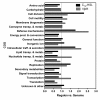Brucella melitensis VjbR and C12-HSL regulons: contributions of the N-dodecanoyl homoserine lactone signaling molecule and LuxR homologue VjbR to gene expression
- PMID: 20529360
- PMCID: PMC2898763
- DOI: 10.1186/1471-2180-10-167
Brucella melitensis VjbR and C12-HSL regulons: contributions of the N-dodecanoyl homoserine lactone signaling molecule and LuxR homologue VjbR to gene expression
Abstract
Background: Quorum sensing is a communication system that regulates gene expression in response to population density and often regulates virulence determinants. Deletion of the luxR homologue vjbR highly attenuates intracellular survival of Brucella melitensis and has been interpreted to be an indication of a role for QS in Brucella infection. Confirmation for such a role was suggested, but not confirmed, by the demonstrated in vitro synthesis of an auto-inducer (AI) by Brucella cultures. In an effort to further delineate the role of VjbR to virulence and survival, gene expression under the control of VjbR and AI was characterized using microarray analysis.
Results: Analyses of wildtype B. melitensis and isogenic DeltavjbR transciptomes, grown in the presence and absence of exogenous N-dodecanoyl homoserine lactone (C12-HSL), revealed a temporal pattern of gene regulation with variances detected at exponential and stationary growth phases. Comparison of VjbR and C12-HSL transcriptomes indicated the shared regulation of 127 genes with all but 3 genes inversely regulated, suggesting that C12-HSL functions via VjbR in this case to reverse gene expression at these loci. Additional analysis using a DeltavjbR mutant revealed that AHL also altered gene expression in the absence of VjbR, up-regulating expression of 48 genes and a luxR homologue blxR 93-fold at stationary growth phase. Gene expression alterations include previously un-described adhesins, proteases, antibiotic and toxin resistance genes, stress survival aids, transporters, membrane biogenesis genes, amino acid metabolism and transport, transcriptional regulators, energy production genes, and the previously reported fliF and virB operons.
Conclusions: VjbR and C12-HSL regulate expression of a large and diverse number of genes. Many genes identified as virulence factors in other bacterial pathogens were found to be differently expressed, suggesting an important contribution to intracellular survival of Brucella. From these data, we conclude that VjbR and C12-HSL contribute to virulence and survival by regulating expression of virulence mechanisms and thus controlling the ability of the bacteria to survive within the host cell. A likely scenario occurs via QS, however, operation of such a mechanism remains to be demonstrated.
Figures




Similar articles
-
Putative quorum-sensing regulator BlxR of Brucella melitensis regulates virulence factors including the type IV secretion system and flagella.J Bacteriol. 2008 May;190(9):3274-82. doi: 10.1128/JB.01915-07. Epub 2008 Feb 29. J Bacteriol. 2008. PMID: 18310341 Free PMC article.
-
Mutations of the quorum sensing-dependent regulator VjbR lead to drastic surface modifications in Brucella melitensis.J Bacteriol. 2007 Aug;189(16):6035-47. doi: 10.1128/JB.00265-07. Epub 2007 Jun 8. J Bacteriol. 2007. PMID: 17557825 Free PMC article.
-
Quorum sensing LuxR proteins VjbR and BabR jointly regulate Brucella abortus survival during infection.J Bacteriol. 2025 Mar 20;207(3):e0052724. doi: 10.1128/jb.00527-24. Epub 2025 Feb 27. J Bacteriol. 2025. PMID: 40013834 Free PMC article.
-
An evolving perspective on the Pseudomonas aeruginosa orphan quorum sensing regulator QscR.Front Cell Infect Microbiol. 2014 Oct 28;4:152. doi: 10.3389/fcimb.2014.00152. eCollection 2014. Front Cell Infect Microbiol. 2014. PMID: 25389523 Free PMC article. Review.
-
Quorum regulation of luminescence in Vibrio fischeri.J Mol Microbiol Biotechnol. 1999 Aug;1(1):5-12. J Mol Microbiol Biotechnol. 1999. PMID: 10941779 Review.
Cited by
-
The Aggregation of Brucella abortus Occurs Under Microaerobic Conditions and Promotes Desiccation Tolerance and Biofilm Formation.Open Microbiol J. 2013 Mar 22;7:87-91. doi: 10.2174/1874285801307010087. Print 2013. Open Microbiol J. 2013. PMID: 23802025 Free PMC article.
-
Altered Transcriptome of the B. melitensis Vaccine Candidate 16MΔvjbR, Implications for Development of Genetically Marked Live Vaccine.Indian J Microbiol. 2012 Dec;52(4):575-80. doi: 10.1007/s12088-012-0293-8. Epub 2012 Aug 2. Indian J Microbiol. 2012. PMID: 24293713 Free PMC article.
-
A functional and phylogenetic comparison of quorum sensing related genes in Brucella melitensis 16M.J Microbiol. 2014 Aug;52(8):709-15. doi: 10.1007/s12275-014-3570-x. Epub 2014 Jul 4. J Microbiol. 2014. PMID: 24994008
-
Genome analysis of quorum sensing Cedecea neteri SSMD04 leads to identification of its novel signaling synthase (cneI), cognate receptor (cneR) and an orphan receptor.PeerJ. 2015 Sep 1;3:e1216. doi: 10.7717/peerj.1216. eCollection 2015. PeerJ. 2015. PMID: 26355540 Free PMC article.
-
Pseudovibriamides from Pseudovibrio marine sponge bacteria promote flagellar motility via transcriptional modulation.mBio. 2025 Feb 5;16(2):e0311524. doi: 10.1128/mbio.03115-24. Epub 2024 Dec 27. mBio. 2025. PMID: 39727420 Free PMC article.
References
Publication types
MeSH terms
Substances
Grants and funding
LinkOut - more resources
Full Text Sources
Molecular Biology Databases

